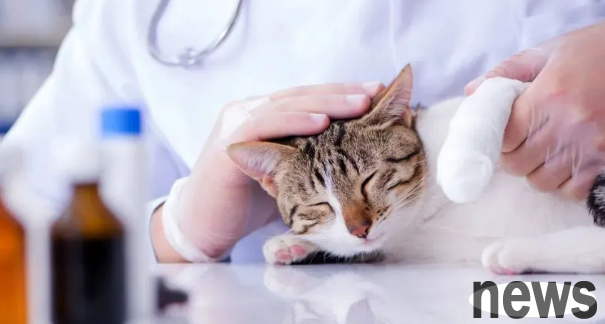Respiratory diseases of cats are common diseases in cats caused by various pathogenic agents such as viruses, bacteria, mycoplasma and chlamydia. It is divided into upper respiratory tract infection of cats (mainly occurring in the nose, pharynx, and throat. Clinical symptoms include: transparent or colored secretions in the eyes or nose, coughing, sneezing, swelling of mucosa around the eyes, purulent nasal snot, etc.) and lower respiratory tract infection of cats (mainly occurring in the trachea, bronchial and alveoli. Main phenotype types: asthma, chronic bronchitis).

Generally speaking, FHV-1 (female herpesvirus type I) and FCV (female calicivirus) are the main causes of upper respiratory tract infection, while lower respiratory tract infections are mostly caused by bacteria.
Female herpes virus (FHV) infection is commonly known as cat nasal branch. It is an acute infectious disease with very strong upper respiratory tract infection. Both cats in the acute infection period and cats in the incubation period can be detoxified through secretions, resulting in direct contact and indirect contact transmission, and can also be transmitted vertically through placenta and breastfeeding. The virus mainly infects kittens, especially kittens aged 4-6 weeks. Once infected, the mortality rate will reach 50%, and the incidence and mortality rate of adult cats are relatively low.
cats will be carried for life after infection, and the virus is lurking in the trigeminal nerve. When cats’ resistance decreases, FHV-1 reboots, causing infection again.
The cats who are suffering from the disease show rhinitis, conjunctivitis, bronchitis, ulcerative stomatitis, etc., with increased body temperature and obvious symptoms of upper respiratory tract infection, manifested as sudden attacks, neutrophil reduction, paroxysmal sneezing or coughing, tears, conjunctivitis, increased nasal secretions, loss of appetite, weight loss, and depression. Nasal fluid and tears are transparent in the early stages and then become mucopurulent.
cat calicivirus (FCV) is a type of genus Aquatic Virus in the family Calicivirus family, and is a single-strand positive-strand RNA virus. It mainly occurs in the cat's oral and upper respiratory tract, also known as cat infectious rhinoconjunctivitis. This virus can be directly transmitted, (oral and nasal secretions, saliva) can also be indirectly transmitted through infectious agents, and it spreads very quickly and is prone to outbreaks in cats. There is only one serotype of
FCV, but it has high volatile properties during the replication of the virus, which makes it show antigenic diversity and can cause mutations to occur faster when immunity is low, resulting in the diversity of poisonous strains in cat groups in different regions. Some of these strains are highly toxic (VS-FCV) and can induce systemic diseases.
Oral, tongue, and hard palate ulcers are common and characteristic clinical symptoms. Cats usually experience sneezing, salivation, serous and mucous rhinitis, biphasic fever, depression, and even pneumonia. Some strains can also cause systemic inflammation such as skin ulcers, jaundice, liver necrosis, pancreatitis, head and foot edema, and some cats may also experience symptoms such as lameness.
Chlamydia is widely distributed worldwide and is an intracellular pathogenic bacteria in various animal species such as humans, cats, pigs, sheep and avians. Chronic acidosis, also known as feline pneumonia, mainly causes eye infections and upper respiratory tract infections. In terms of pathogenic nature, it is not limited to infection of the eyes and respiratory tract, it can become a pathogen of systemic infection, which means that untimely treatment may develop into systemic chlamydia infection.

In the diagnosis of respiratory diseases of cats, since the clinical manifestations of infections of different pathogens are similar, and mixed infections of viruses and bacteria in multiple cats are common, more detection methods are needed to conduct comprehensive diagnosis. In addition to clinical symptom examinations, common hematological examinations (routine blood tests and cat serum amyloid A tests), imaging examinations (respiratory tract symptoms or suspected lung inflammation) and nucleic acid detection analyzer pathogen diagnosis (Qiaoyijie cat respiratory five-combination test, which can determine the cause and accurately treat it).
Some experts believe that raising four cats at the same time will increase the infection rate of FCV. In order to reduce the risk of respiratory diseases in cats, pet owners are advised to control the number of feeding. Pet shops, breeding farms, etc. should be disinfected regularly to avoid large temperature differences from causing stress responses to cats. After treating the cat, change clothes and wash hands, ventilate indoors frequently, clean cat tableware regularly with disinfectants, and get vaccinated regularly, which is also helpful for controlling diseases. The main ways of transmission of respiratory diseases in cats are close contact and environmental pollutants. Isolation, environmental disinfection, and reducing the number of cats can reduce the infection rate.
